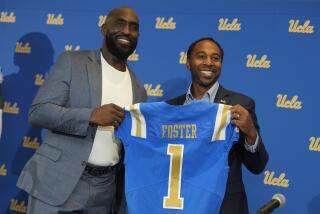CS Fullerton to Drop Football; Costs Cited : Economics: School president says move to less-expensive Division I-AA is planned for 1994.
- Share via
The bubble that Cal State Fullerton’s Division I-A football program has been floating on for the last two years finally burst Monday when school President Milton A. Gordon announced the sport would be dropped.
But Gordon, who made his decision after reviewing the athletic department’s budget and campus and community support for football, said the school intends to restore the sport at the less-expensive Division I-AA level in 1994.
“We tried hard to raise sufficient funds to play I-A football, but have not been successful,” Gordon said. “All the state budget cuts haven’t made it easier, but you can’t avoid reality. This decision is in the best interest of the university.”
Among the benefits of the move:
--Players can transfer to another school without losing a year of eligibility. Had Fullerton downgraded to I-AA football for next season, players wishing to transfer to I-A programs would have had to sit out a year before becoming eligible. “I think a majority of them will be happy,” said Gene Murphy, who retired after 13 years as Titan coach.
--The school can wait until next summer or early fall to hire a new coach, who can take his time assembling a staff and spend the season evaluating high school and community college players and scouting the new I-AA Western Football Conference, which Fullerton hopes to join in 1994. “I’d like to use 1993-94 as a rebuilding year,” Gordon said.
--The athletic department can trim its projected budget deficit from about $350,000 to $60,000 this year, with almost all of the savings coming in coaching salaries.
By the end of the 1993-94 school year, Athletic Director Bill Shumard projects the department will have a surplus of about $13,000 without football, which took up $1.2 million of the school’s $4.9 million athletic budget.
“This has been a cloud of apprehension since I came here,” said Shumard, who was hired in August of 1991. “We know our direction, we can plan for it, and there’s a commitment to it. That’s exciting.”
But how firm is that commitment to football in 1994? That is difficult to determine.
Shumard said the athletic department will need an additional $250,000 a year to play in the Western Football Conference, where teams will be limited to four coaches and 12 scholarships (Division I programs are allowed nine coaches and 92 scholarships). But neither Gordon nor Shumard could say where those funds would come from.
A $5-million capital campaign to benefit the athletic department and the Titan Sports Complex, launched in 1991 when Gordon decided to retain football despite an Athletics Council recommendation to drop it, has netted only $1.5 million in pledges. About $800,000 of that has already been spent on 1991-92 operating expenses.
And all indications point toward the state budget situation getting worse next year.
“There’s always a possibility (we won’t bring football back), but we’ll have better knowledge of the 1993-94 budget before we begin a course of action,” Gordon said. “It’s my intention to start recruiting a new coach next summer and return in 1994.”
Fullerton is the second Big West Conference school in the last year to drop football, following Cal State Long Beach’s move last winter. Several NCAA schools, including Drake and West Texas State in recent years, have suspended their football program and restored it the next year.
More to Read
Get our high school sports newsletter
Prep Rally is devoted to the SoCal high school sports experience, bringing you scores, stories and a behind-the-scenes look at what makes prep sports so popular.
You may occasionally receive promotional content from the Los Angeles Times.







